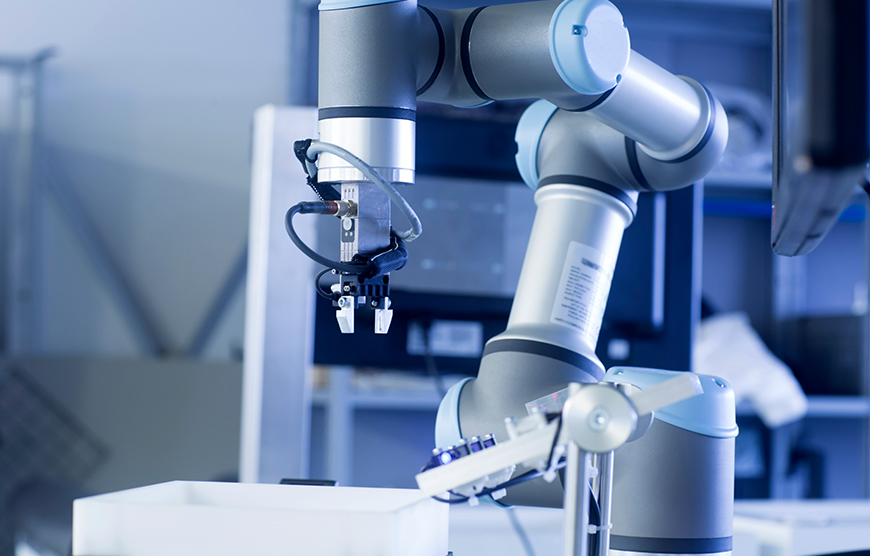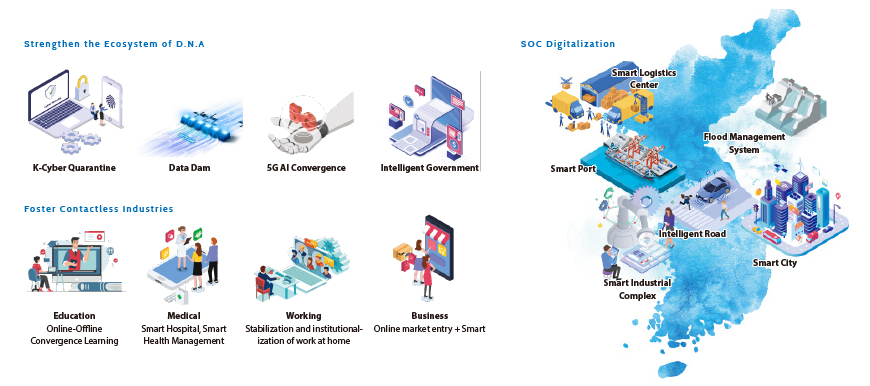- Home
- Investment Opportunities
- Latest Information
- Industry Focus
Industry Focus
- ICT

Current Status of Korea’s Robotics Industry
The Korean robotics industry has been growing at an annual average rate of 4.5 percent in the past five years, recording KRW 5.4 trillion sales as of 2020. When it comes to robot density, the number of operational robots per 10,000 employees, Korea was ranked 1st (932 units) in 2020. Manufacturing robots account for 52.4 percent of the Korean robot market, leading the market growth. The share of service robots is relatively smaller at 15.6 percent, but it has entered an explosive growth stage with sales jumping 34.9 percent (KRW 638.5 billion → KRW 857.7 billion) year-on-year. In the past, the center of gravity in the Korean robotics industry lied mainly on manufacturing robots. However, the size of the service robot market has been on the rise, with large Korean conglomerates scaling up the robot business and entering the market in earnest through M&A and the establishment of subsidiaries. The comprehensive technological competitiveness of the Korean robot was ranked the 4th (2018 technology evaluation, KISTEP), with some robot applications and service technologies being highly regarded. In addition, government-led R&D investment is underway mainly due to the country’s SME-oriented industrial structure.
Efforts to develop the Robotics Industry as a National Agenda
The Korean government enacted the Intelligent Robot Development and Distribution Promotion Act in 2008, establishing and pursuing policy measures for sustainable development of the robotics industry by promoting the development and promotion of robots, thereby developing the robotics industry as the nation’s key industry. Based on the aforementioned Act, the ‘Intelligent Robot Basic Plan’ was established every five years, building the government-wide robotics industry support system. The 1st and 2nd Basic Plans (2009, 2014) created the government-led support system, areas for support, and foundation for growth. The 3rd Basic Plan (2019) is pushing for systematic distribution and dissemination through selection and focus, and responsibility-sharing between the government and private sector. Due to the peculiarity of the robotics sector, i.e., broadly related industries both upstream and downstream, each government department is pushing for policy projects to foster and advance the robotics industry. Meanwhile, the budget for robot-related R&D, distribution and demonstration, and talent development in 2021 was about KRW 195 billion, 29 percent up from the previous year, indicating the continuous expansion of national investment in the robotics industry.
| Ministry | Project Name | Details |
|---|---|---|
| Ministry of Trade, Industry and Energy (MOTIE) | Collaborative Intelligence (CI)-based Robot Plus Competitiveness Support Project | - Support the infrastructure establishment for demonstration and commercialization operation technology to support productivity increase of SMEs by applying CI technology to general machines and robots (2020-2024) |
| 5G-based High-tech manufacturing robot demonstration support center establishment | - Support full life-cycle test/certification such as high-tech manufacturing robot demonstration, robot S/W reliability, and 5G wireless performance verification through the establishment of demonstration infrastructure and equipment on mock-up manufacturing environment (2019-2023) | |
| Ministry of Land, Infrastructure and Transport (MOLIT) | Digital logistics demonstration complex establishment support project | - Support demonstration of logistics services (Selected in 2021: Gimcheon-si, Gyeongbuk-do, Busan-si, Jinan-gun, Jeju-do) - Support establishment of logistics pilot cities (Selected in 2021: Hwaseong-si, Busan-si) |
| Ministry of SMEs and Startups (MSS) | Regulation Free Special Zone | - (Daegu) Demonstration of mobile collaborative robots for contactless services in living space and mobile collaborative robots in manufacturing and producing processes (Nov. 2020-current) - (Sejong) Demonstration of autonomous driving outdoor robot operation (Nov. 2020-current) |
| Ministry of Agriculture, Food and Rural Affairs (MAFRA) | Creation of high-tech unmanned automated agricultural production pilot complex | - Establishment of a pilot agricultural production system complex using high-tech agricultural machinery including autonomous driving unmanned tractors, drones for agriculture, and robots for agriculture (2020-2023) |
The ‘Korean New Deal’ was announced in July 2020 in response to the contactless and digitalization trends, to accelerate digital-based economic innovation, and create jobs. The tasks of the robotics industry, a pillar of the Digital New Deal, can be largely summarized as follows, with the first part being the expansion of 5G, and AI convergence across 1st, 2nd, and 3rd industries. To promote digital transformation across all industries and create new markets, the robot convergence project applying 5G and AI technologies to industrial sites will be implemented. The second part is to build infrastructure for smart medicine and medical care. By utilizing robots, robot rehabilitation hospitals and robot surgery operating hospitals will be supported, while socially vulnerable groups including the disabled and the elderly will receive more support and enhanced benefits. The third part is digital transformation for urban areas and industrial complexes. Based on industrial complex and special business areas, large-scale demonstration will be carried out by selecting various robot utilization models.

The Korean government set up a regulation innovation roadmap for autonomous vehicles, drones, hydrogen and electric vehicles, VR, AR, and AI in November 2018 to prevent regulations from standing in the way of new promising industries. The robotics industry is a key new industry, expected to continue growing at a fast pace. In this regard, the ‘Roadmap for Proactive Regulation Innovation of the Robotics Industry’ was laid out with the anticipation of the technology development and commercialization stage in October 2020, to respond to business models using robots. The 1st stage (2020-2022), the demonstration basis building stage, will establish the measures to support demonstration by area and subsidies. The 2nd stage (2023-2025), the preparation for diffusion of robotics industry stage, will support diffusion by commercialization stage and linking with infrastructure. The 3rd stage (2026~), the commercialization response stage, will promote robot dissemination in the private sector and further expansion by sector.
Korea’s investment environment in preparation to leap forward as a global powerhouse in the robotics industry
By Jun-Gyo Seo, Ph.D / Ph.D. (sjk@kiria.org)
Korea Institute for Robot Industry Advancement
< The opinions expressed in this article are the author’s own and do not reflect the views of KOTRA.>










